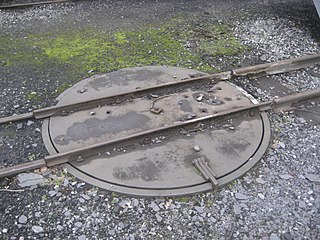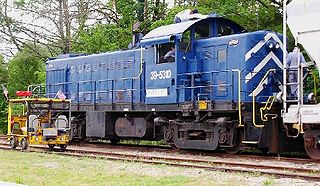History
Working in railway yards or along sidings, during the pioneering years of rail transport, switchmen as a group suffered large numbers of grievous bodily injuries, including in particular crushing injuries and amputations, owing to their work in close proximity to moving trains. An early issue of the American Switchmen's Magazine, in the introduction to a piece on long-serving switchmen, described the dangers:
"The vocation is the most dangerous of any of the different branches of railroading, and that they live for years is only due to their extreme carefulness. The least misstep will often result in crippling a man for life. Their hours of work are long, and the labour very hard, and rain or shine they have to be at their posts. There is no protection for them from the rains of summer, nor the freezing winds and snows of winter. On their efficient work, the great commercial interests of the country largely depend, and only a little carelessness on their part may result in immense damage to the goods in transit, and an error in delivery sometimes causes the loss of an entire consignment of freight, if it happens to be perishable." [1]
Today's American switchman often works as part of three-member switching crew consisting of a Locomotive Engineer, Foreman and Switchman. The Foreman, in charge of the loading of rail cars, is responsible for giving direction to the switchman in order to ensure cars are lined into the correct track and blocked correctly with like cars scheduled to a similar destination, with the engineer in charge of moving the locomotive.

Rail transport is a means of transport using wheeled vehicles running in tracks, which usually consist of two parallel steel rails. Rail transport is one of the two primary means of land transport, next to road transport. It is used for about 8% of passenger and freight transport globally, thanks to its energy efficiency and potentially high speed.

The Union Pacific Railroad is a Class I freight-hauling railroad that operates 8,300 locomotives over 32,200 miles (51,800 km) routes in 23 U.S. states west of Chicago and New Orleans. Union Pacific is the second largest railroad in the United States after BNSF, with which it shares a duopoly on transcontinental freight rail lines in the Western, Midwestern and West South Central United States.

A switcher locomotive, shunter locomotive, or shifter locomotive is a locomotive used for maneuvering railway vehicles over short distances. Switchers do not usually move trains over long distances, instead they typically assemble trains in order for another locomotive to take over. Switchers often operate in a railyard or make short transfer runs. They may serve as the primary motive power on short branch lines or switching and terminal railroads.
Rail transport terms are a form of technical terminology applied to railways. Although many terms are uniform across different nations and companies, they are by no means universal, with differences often originating from parallel development of rail transport systems in different parts of the world, and in the national origins of the engineers and managers who built the inaugural rail infrastructure. An example is the term railroad, used in North America, and railway, generally used in English-speaking countries outside North America and by the International Union of Railways. In English-speaking countries outside the United Kingdom, a mixture of US and UK terms may exist.
Rail transport operations are the day-to-day operations of a railway. A railway has two major components: the infrastructure and the rolling stock

In rail terminology, a railway turntable or wheelhouse is a device for turning railway rolling stock, usually locomotives, so that they can be moved back in the direction from which they came. it is especially used in areas where economic considerations or a lack of sufficient space have served to weigh against the construction of a turnaround wye. In the case of steam locomotives, railways needed a way to turn the locomotives around for return trips as their controls were often not configured for extended periods of running in reverse and in many locomotives the top speed was lower in reverse motion. In the case of diesel locomotives, though most can be operated in either direction, they are treated as having "front ends" and "rear ends". When a diesel locomotive is operated as a single unit, the railway company often prefers, or requires, that it be run "front end" first. When operated as part of a multiple unit locomotive consist, the locomotives can be arranged so that the consist can be operated "front end first" no matter which direction the consist is pointed. Turntables were also used to turn observation cars so that their windowed lounge ends faced toward the rear of the train.

A siding, in rail terminology, is a low-speed track section distinct from a running line or through route such as a main line, branch line, or spur. It may connect to through track or to other sidings at either end. Sidings often have lighter rails, meant for lower speed or less heavy traffic, and few, if any, signals. Sidings connected at both ends to a running line are commonly known as loops; those not so connected may be referred to as single-ended or dead-end sidings, or stubs.

A road switcher locomotive is a type of railroad locomotive designed to both haul railcars in mainline service and shunt them in railroad yards. Both type and term are North American in origin, although similar types have been used elsewhere.

A rail yard, railway yard, railroad yard (US) or simply yard, is a series of tracks in a rail network for storing, sorting, or loading and unloading rail vehicles and locomotives. Yards have many tracks in parallel for keeping rolling stock or unused locomotives stored off the main line, so that they do not obstruct the flow of traffic. Cars or wagons are moved around by specially designed yard switcher locomotives (US) or shunter locomotives (UK), a type of locomotive. Cars or wagons in a yard may be sorted by numerous categories, including railway company, loaded or unloaded, destination, car type, or whether they need repairs. Yards are normally built where there is a need to store rail vehicles while they are not being loaded or unloaded, or are waiting to be assembled into trains. Large yards may have a tower to control operations.

Rail freight transport is the use of railways and trains to transport cargo as opposed to human passengers.

The California Northern Railroad is one of several Class III short-line railroad companies owned by Genesee & Wyoming, Inc. It operates over Southern Pacific Railroad (SP) tracks under a long-term lease.
This article contains a list of terms, jargon, and slang used to varying degrees by railfans and railroad employees in the United States and Canada. Although not exhaustive, many of the entries in this list appear from time to time in specialist, rail-related publications. Inclusion of a term in this list does not necessarily imply its universal adoption by all railfans and railroad employees, and there may be significant regional variation in usage.
The Buffalo switchmen's strike was a two-week strike in August 1892 by railroad workers employed by three railroads in Buffalo, New York. The strike collapsed after two weeks when 8,000 state militia entered the town and other unions refused to support the workers.
A freight conductor is a person who is employed by a railroad. The freight conductor is the lead employee assigned to a freight train, and is responsible for the smooth operation of the assignment, which includes reviewing schedules and maintaining communication with the train's crew members.

The Switchmen's Union of North America (SUNA) was a labor union formed in October 1894 that represented the track switch operators and people who coupled railway cars in railway yards in the United States and Canada. It became part of the United Transportation Union in 1969.

The Switchmen's Mutual Aid Association of North America (SMAA) was a 19th-century fraternal benefit society and trade union in the United States of America. Its members included the operators of railway track switches and those who coupled train cars in railway yards. Organized in 1886, the union came to its demise in July 1894 with rise of the American Railway Union and the smashing defeat it was delivered in the 1894 Pullman Strike. The organization was succeeded in October 1894 with the establishment of the Switchmen's Union of North America.

On 13 December 2018, a high-speed passenger train and a locomotive collided near Yenimahalle in Ankara Province, Turkey. Three cars of the passenger train derailed in the collision. Three railroad engineers and five passengers were killed at the scene, and 84 people were injured. Another injured passenger later succumbed to injuries, and 34 passengers, including two in critical condition, were treated in several hospitals.

The Harvey train collision took place on October 12, 1979, when the Shawnee train operated by Amtrak between Carbondale and Chicago Union Station crashed into a parked Illinois Central Gulf freight train, leading to the death of two crew members.















